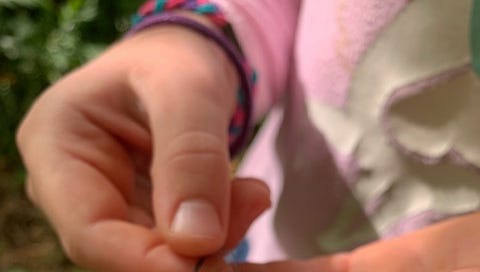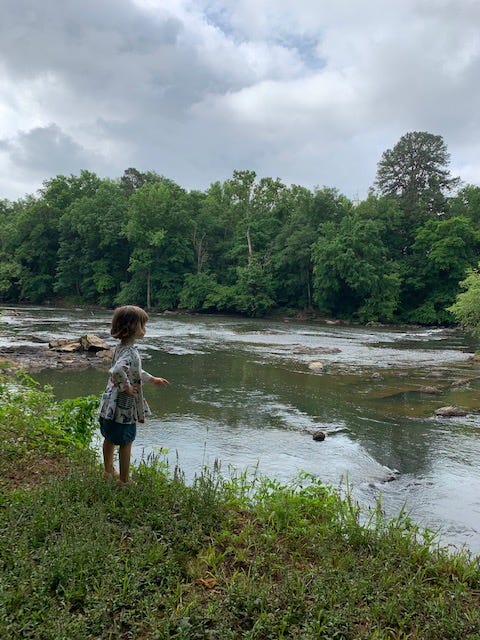(Dragonfly wings found on the trail. Some dragonflies complete a migration that takes place over 4,400 open-water miles and four generations.)
A couple of weeks ago, Louise commented on our Tough Girls’ Guide to Hiking that “kids don’t really get tired, they get bored,” which rang true for me. I used to take my fifth grade class on walks from our school to the Life and Science Museum in Durham, which was about a two-mile hike on the American Tobacco Trail. To keep ourselves motivated, we had to have games and diversions along the way (and a mom or dad waiting with popsicles, at the end).
Louise suggested a trail version of the game of Sardines, which I wish I’d known about then:
ONE person hides while everyone else closes their eyes and counts. Then everyone tries to find the person who hid, and when you find them you hide WITH them, in the same spot.
When I play sardines on the trail, I ask the person who is hiding to hide near something they think is cool. When we've all found them they can share about the cool thing. It's lots of fun.
I love this trail-hiking twist, and I know that as director of Clapping Hands Farm (a camp Bea loved during spring break, and will return to in August), Louise has lots of ideas about fun outdoor games (that can also be Covid-safe), which you can play at camp, family reunions, and in your own backyard. Bea says she can’t name a favorite game she learned at camp because “they were all so much fun,” but she especially liked Dragon’s Egg (a sneaking game) and Watch Your Back (a tagging game with pool noodles).
These ideas made me remember another game that’s tons of fun if you have a lot of kids playing, and was even fun with just our family of four. I learned it a retreat I went to at the headwaters of the Haw River, I think with the same fifth graders who used to trek to Life & Science with me (local folks, did you know that Life & Science used to be free for schools and Durham residents?).
It’s called “Animal Migration.” Here’s how you play:
1. Find a big open space. Place sticks or other markers to show where the animals will start and finish their migrations.
2. One person is “it.” They stand in the center, but can move around/run/etc. Their goal is to tag the migrating animals. Once an animal is tagged, they become “it” and tag the remaining migrating animals too.
3. Before the game starts, each non-it player thinks of an animal. If you’re playing with older kids or kids with a lot of science knowledge, you can make this a migrating animal, but you can also just keep it about animals and their characteristics. When we play with Harriet, we let her think of her animal and “whisper” it to Bea, who can help (usually she says it out loud).
4. The person who is “it” yells out characteristics of an animal. So, they might say “If your animal lives in the water… run!” If Bea had, for example, chosen a sea turtle, she’d run to the other side, past the sticks, trying to avoid being tagged. If she got tagged, then she’d become it too.
5. The game gets harder as you go along, but having people keep playing makes it more fun for everyone, and means you don’t have to wait your turn, which is for me the worst part of game play, and why I far prefer Bananagrams over Scrabble. Whoever is tagged first is it next time.
Do you have any favorite summer or outdoor games? What about pool games? I really love the way games can bring kids who don’t even know each other yet together.
I think you could adapt this game to make it more science-based, like focusing on animals that migrate. Here is a great story on the most amazing animal migrations.
Or you can make it more challenging—especially if you have a nice big field to run in—by giving the animals more obstacles or threats. For example, “you’ve been hanging out with too many humans, so hop three times as you run across.” Here are some links to threats faced by migrating animals.
And here are some things your family can do to help monarchs with their incredible, 3,000-mile migration!
(Harriet spotting turtles at the Haw River.)





